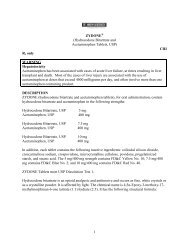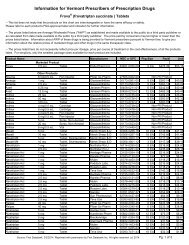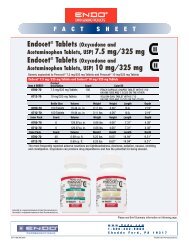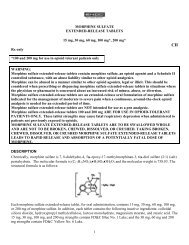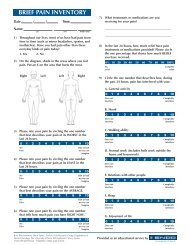percocet - Endo Pharmaceuticals
percocet - Endo Pharmaceuticals
percocet - Endo Pharmaceuticals
Create successful ePaper yourself
Turn your PDF publications into a flip-book with our unique Google optimized e-Paper software.
12. Patients who are treated with PERCOCET tablets for more than a few weeks should be<br />
advised not to abruptly discontinue the medication. Patients should consult with their<br />
physician for a gradual discontinuation dose schedule to taper off the medication.<br />
13. Patients should be advised that PERCOCET tablets are a potential drug of abuse. They<br />
should protect it from theft, and it should never be given to anyone other than the individual<br />
for whom it was prescribed.<br />
Laboratory Tests<br />
Although oxycodone may cross-react with some drug urine tests, no available studies were found<br />
which determined the duration of detectability of oxycodone in urine drug screens. However,<br />
based on pharmacokinetic data, the approximate duration of detectability for a single dose of<br />
oxycodone is roughly estimated to be one to two days following drug exposure.<br />
Urine testing for opiates may be performed to determine illicit drug use and for medical reasons<br />
such as evaluation of patients with altered states of consciousness or monitoring efficacy of drug<br />
rehabilitation efforts. The preliminary identification of opiates in urine involves the use of an<br />
immunoassay screening and thin-layer chromatography (TLC). Gas chromatography/mass<br />
spectrometry (GC/MS) may be utilized as a third-stage identification step in the medical<br />
investigational sequence for opiate testing after immunoassay and TLC. The identities of 6-keto<br />
opiates (e.g., oxycodone) can further be differentiated by the analysis of their methoximetrimethylsilyl<br />
(MO-TMS) derivative.<br />
Drug/Drug Interactions with Oxycodone<br />
Opioid analgesics may enhance the neuromuscular-blocking action of skeletal muscle relaxants<br />
and produce an increase in the degree of respiratory depression.<br />
Patients receiving CNS depressants such as other opioid analgesics, general anesthetics,<br />
phenothiazines, other tranquilizers, centrally-acting anti-emetics, sedative-hypnotics or other<br />
CNS depressants (including alcohol) concomitantly with PERCOCET tablets may exhibit an<br />
additive CNS depression. When such combined therapy is contemplated, the dose of one or both<br />
agents should be reduced. The concurrent use of anticholinergics with opioids may produce<br />
paralytic ileus.<br />
Agonist/antagonist analgesics (i.e., pentazocine, nalbuphine, naltrexone, and butorphanol) should<br />
be administered with caution to a patient who has received or is receiving a pure opioid agonist<br />
such as oxycodone. These agonist/antagonist analgesics may reduce the analgesic effect of<br />
oxycodone or may precipitate withdrawal symptoms.<br />
Drug/Drug Interactions with Acetaminophen<br />
Alcohol, ethyl: Hepatotoxicity has occurred in chronic alcoholics following various dose levels<br />
(moderate to excessive) of acetaminophen.<br />
Anticholinergics: The onset of acetaminophen effect may be delayed or decreased slightly, but<br />
the ultimate pharmacological effect is not significantly affected by anticholinergics.<br />
8



